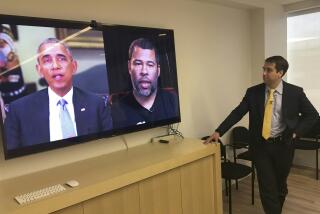A Mark of Genius or Sneakiness?
- Share via
So there I am in front of my computer, holding a magazine advertisement up to the sort of little camera used to e-mail pictures of the kids to Granny. And then--bam!--my Web browser whisks me to the product’s Web page.
There’s a secret code buried on that piece of paper--invisible to humans but as plain as day to the camera. This code triggers the computer to perform various tasks: Go to a Web site, play some music, download some software. Suddenly, using the Internet is as easy as opening a magazine.
This is incredibly powerful stuff because it makes computers idiot-simple--so simple that any chief executive will be able to operate one.
But it’s also got some frightening aspects.
Because the markings are invisible to the naked eye they could be placed on common, everyday objects, and you would never notice. With computer cameras spreading like rabbits, it’s not at all hard to imagine that this new technology would have made former FBI Director J. Edgar Hoover--who maintained his power by collecting information on people through electronic bugs and paid informers--very happy.
In effect, we now have the ability to track people as they roam around. And it becomes as easy as selling them a T-shirt. In the same way the code can tell a computer to zoom to a particular Web site, it could also log every time you linger at the water cooler or track which stores you frequent at the mall.
But the folks who developed this technology, Digimarc Corp., say none of that will happen. “We take privacy very, very seriously,” said Indra Paul, vice president and general manager of the Digimarc MediaBridge. “We don’t know who you are, and we don’t collect any personal information.”
That’s Digimarc. But other people will doubtless develop similar systems. And they might not have such scruples.
The system Digimarc developed requires a little preparation on the part of users. If you’ve got a typical camera attached to your box, you need to visit a Digimarc Web site, https://www.lookforthed.com, to download a bit of software. Suddenly your camera can see much more than it ever has before.
The technology is based on Digimarc’s electronic watermarking system, which lets the owner of any digitized image embed a code that can be tracked and used to verify claims of ownership. In a digitized universe, where it’s all too easy to appropriate someone else’s work, such tools will play a key role in ensuring that artists make enough money off their work to produce new stuff.
At the moment, the technology works, but it’s finicky. I had to hold the magazine ad about 4 inches from the camera. Setting the focus properly was critical.
Right now, more than 150 publications have licensed the Digimarc technology to produce advertisements and editorial content that can interact with a reader’s computer. More exotic applications are on the horizon. For instance, you’ll soon see coffee sleeves--dense paper designed to protect your hand from a paper cup filled with hot java--painted with digital watermarks that will take users to special Web pages.
The technology transforms the way we work with computers. You won’t need to type in an obscure Web address. Just hold that newspaper page up to the camera to get to the right place. This is so different from reality as we know it today that people are just beginning to get their heads around the possibilities.
For instance, let’s say you have one of those really complicated digital watches with lots of functions--most of which you have long since forgotten how to use. The manufacturer can paint an invisible code on the watchband or the back of the watch that, when waved in front of a computer connected to the Internet, can instantly take you to a copy of the instruction manual for your model.
Similar technology is already on the market, but the Digimarc setup is a little less clumsy. For instance, CueCat is a mouse-sized device that plugs into a computer and can read things such as bar codes from magazines and then take the user to a Web page. Gizmos such as CueCat have already raised hackles among privacy advocates, who fear that such technologies will make it easier for corporate America to track our movements throughout cyberspace.
Digimarc’s Paul insists his company understands such concerns and has designed its products so that they meet the needs of the companies that pay for them but protect the privacy of users. “That’s the way our systems are designed.”
All very well, but given that Digimarc’s technology--or something very much like it--can be triggered passively by any consumer who unknowingly waves an encoded object in front of an Internet camera, don’t we need to be concerned? Digimarc has already developed T-shirts that have an invisible code embedded in the design that can be picked up by any properly configured camera.
Doesn’t that give Paul the creeps?
“Well, it’s a matter of how you use it,” he said. “We understand the privacy part of the technology very well.”
Here’s hoping they’ve got ironclad patents on that type of technology. Otherwise, very soon, that free T-shirt you pick up at the local fair might be telling people more about you than you could imagine.
*
Columnist Dave Wilson writes about technology for The Times.






